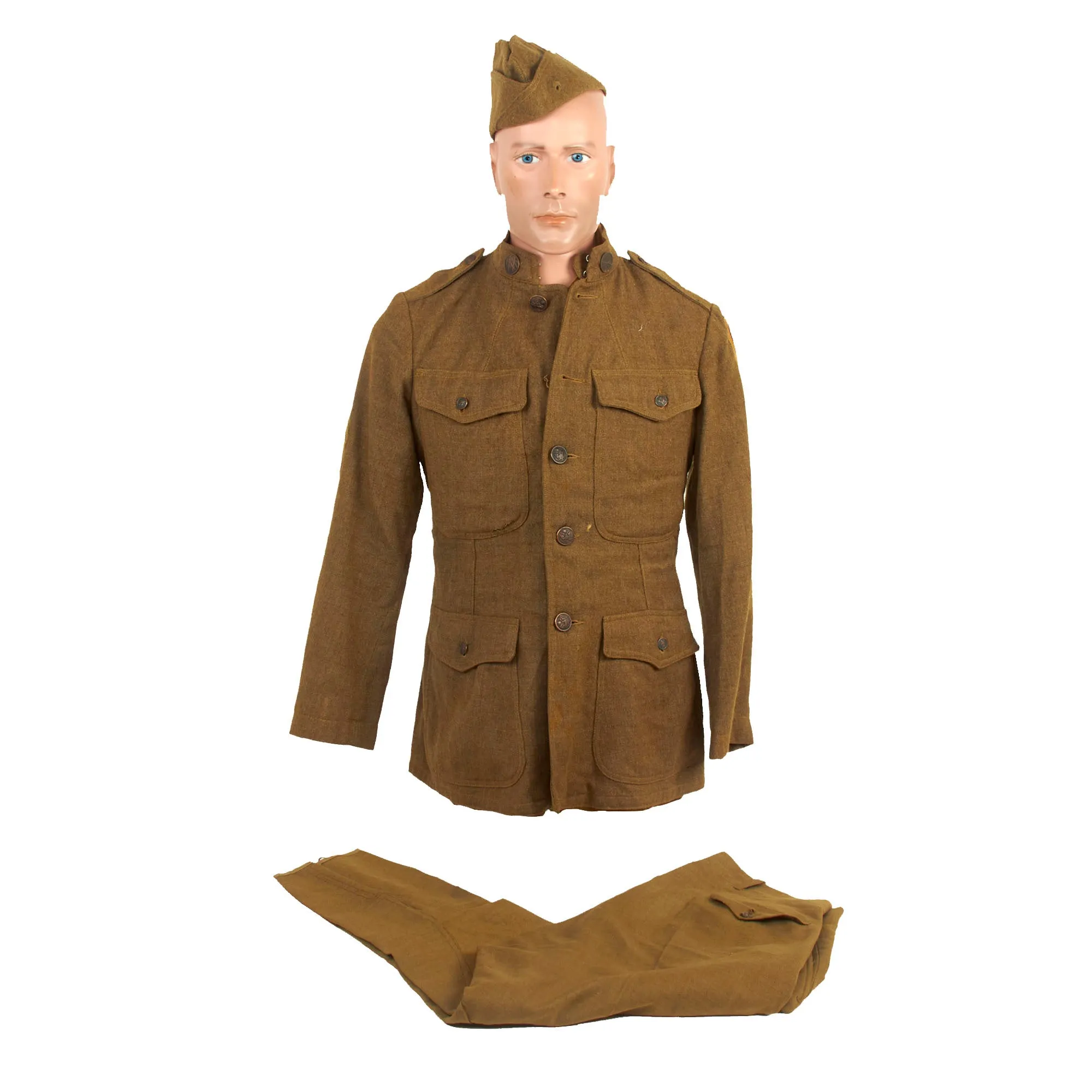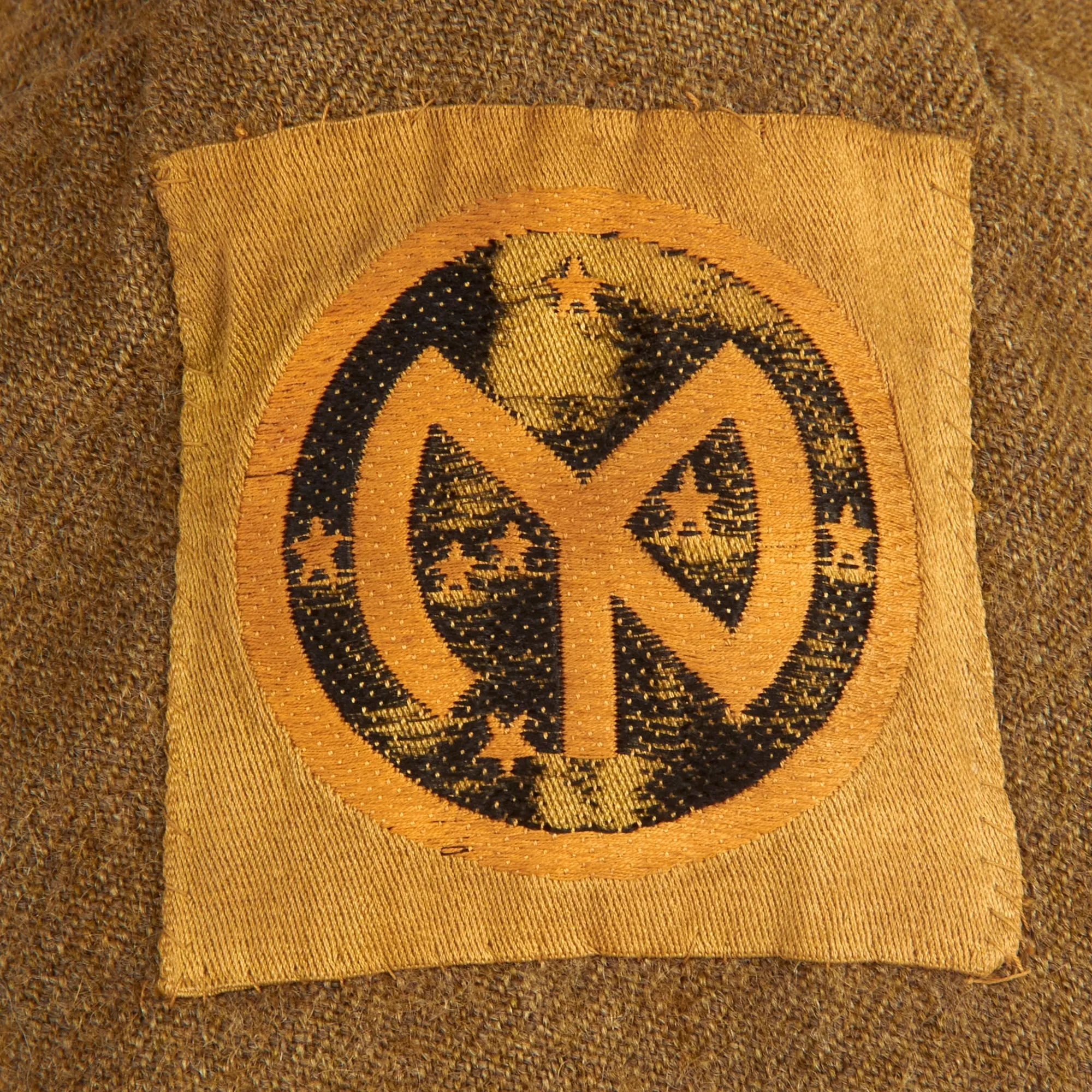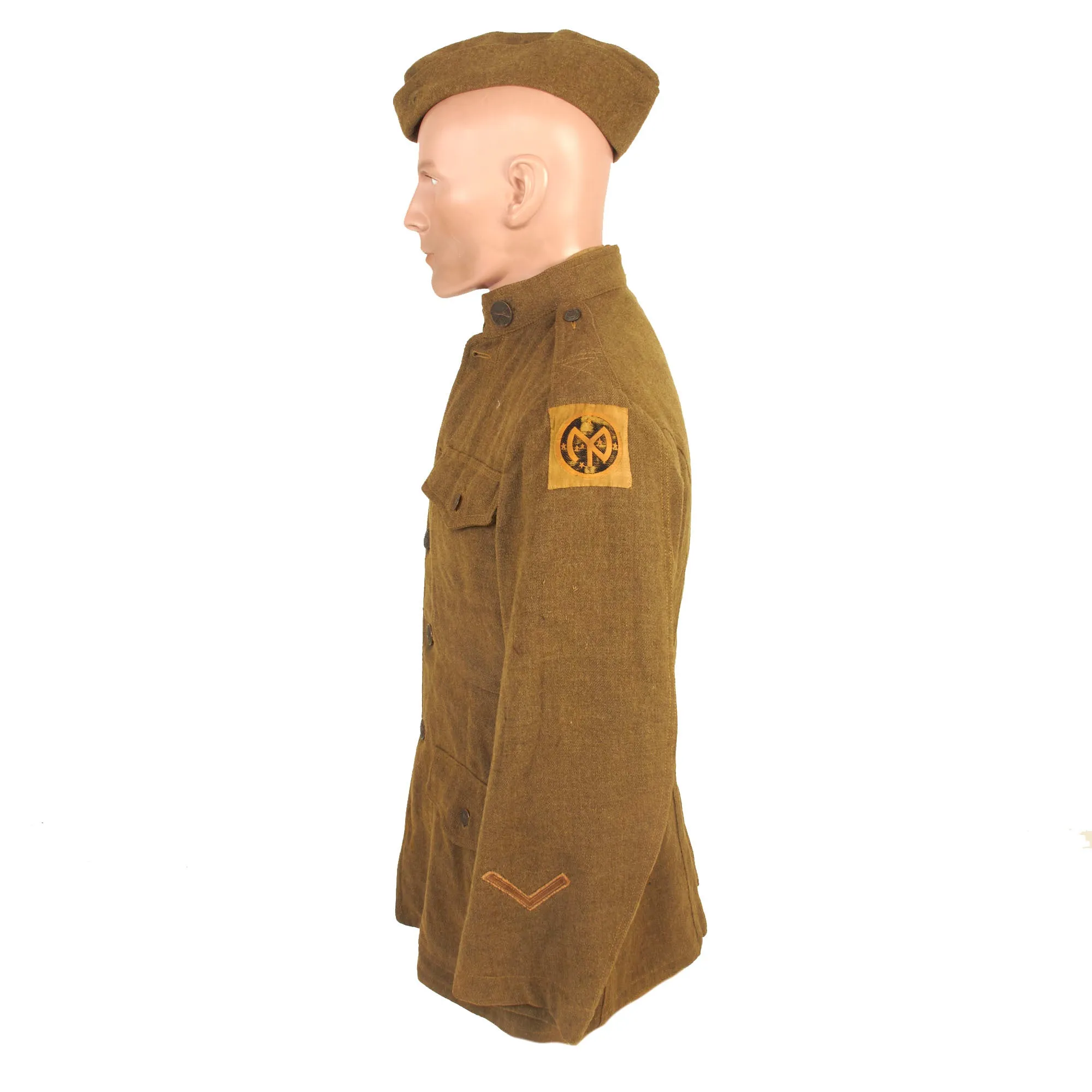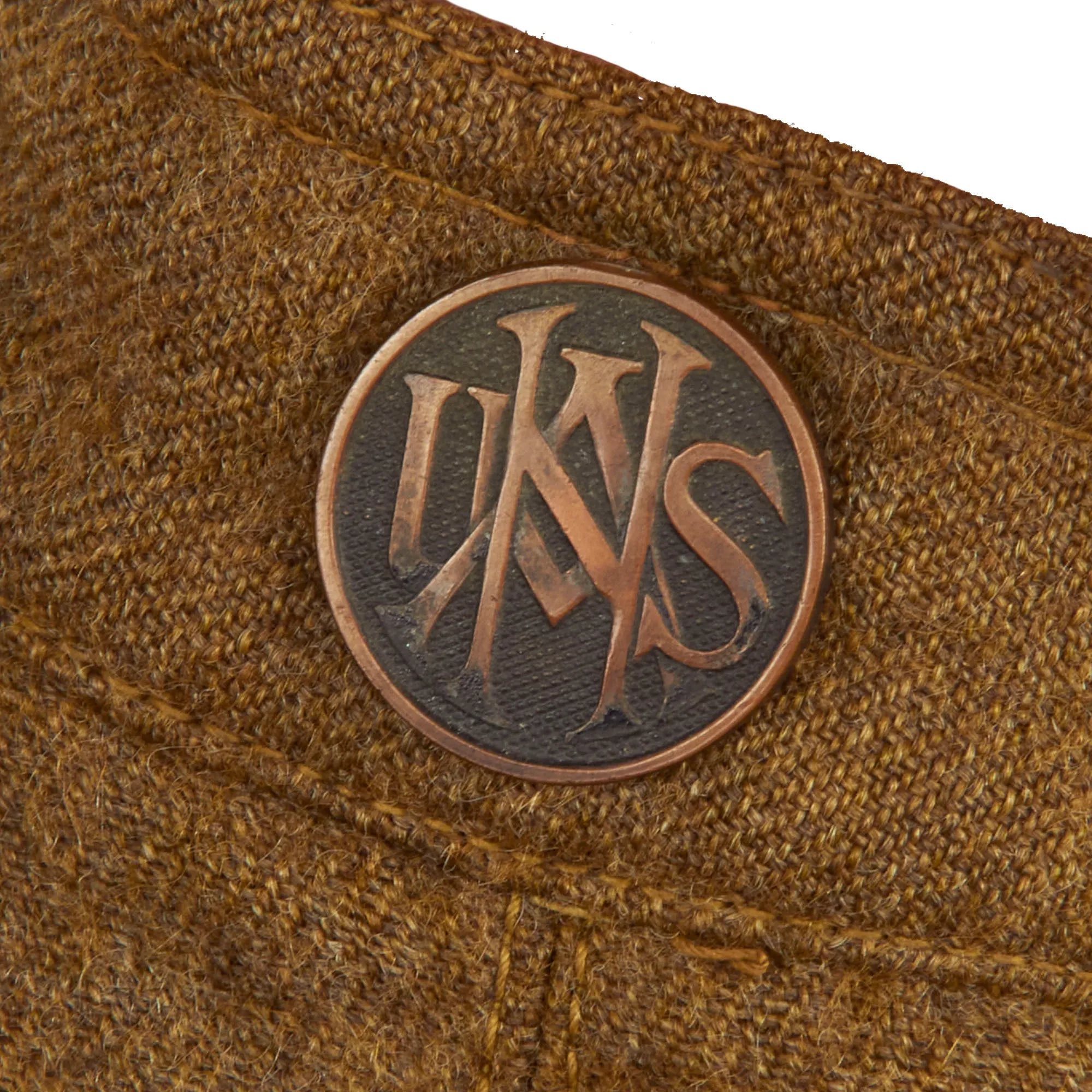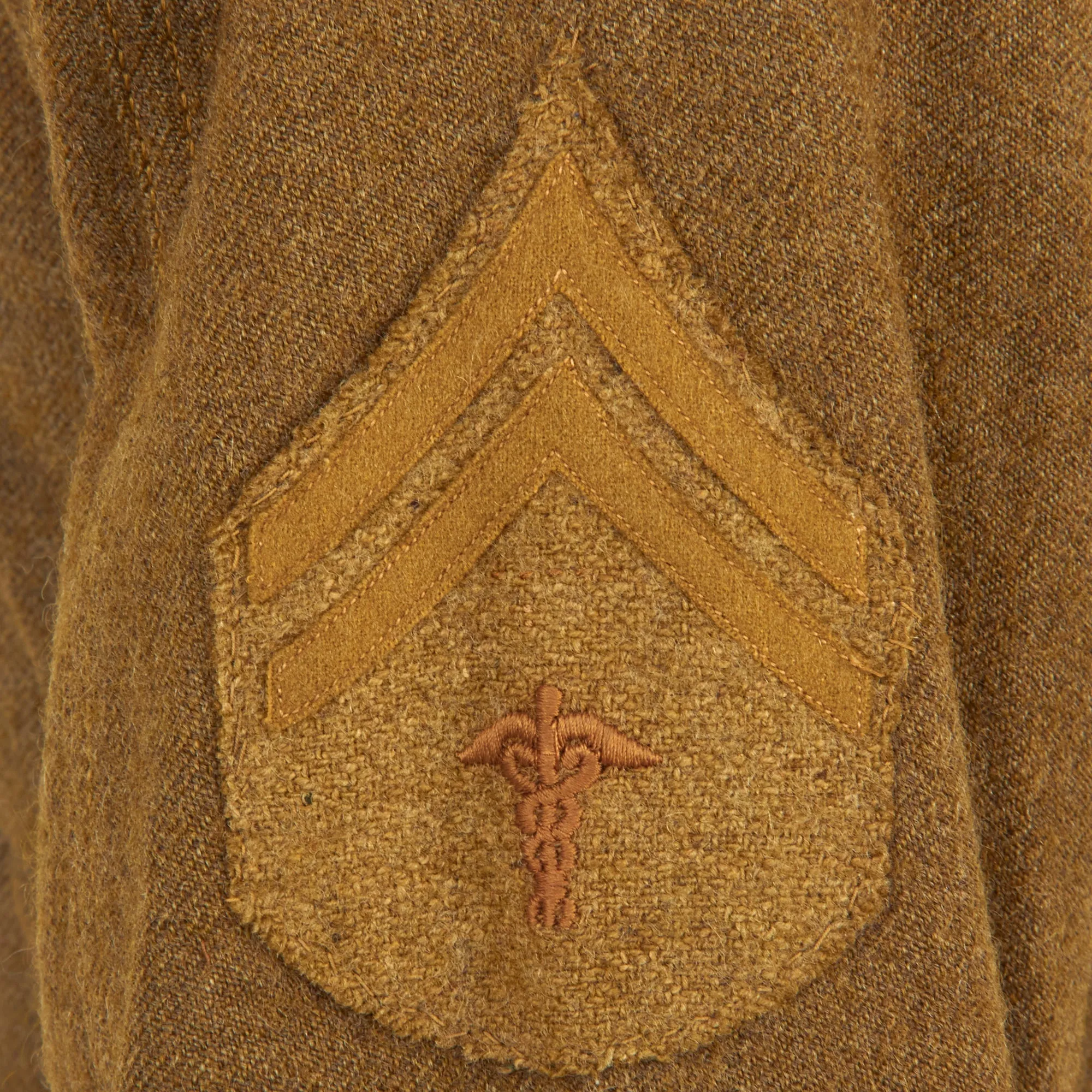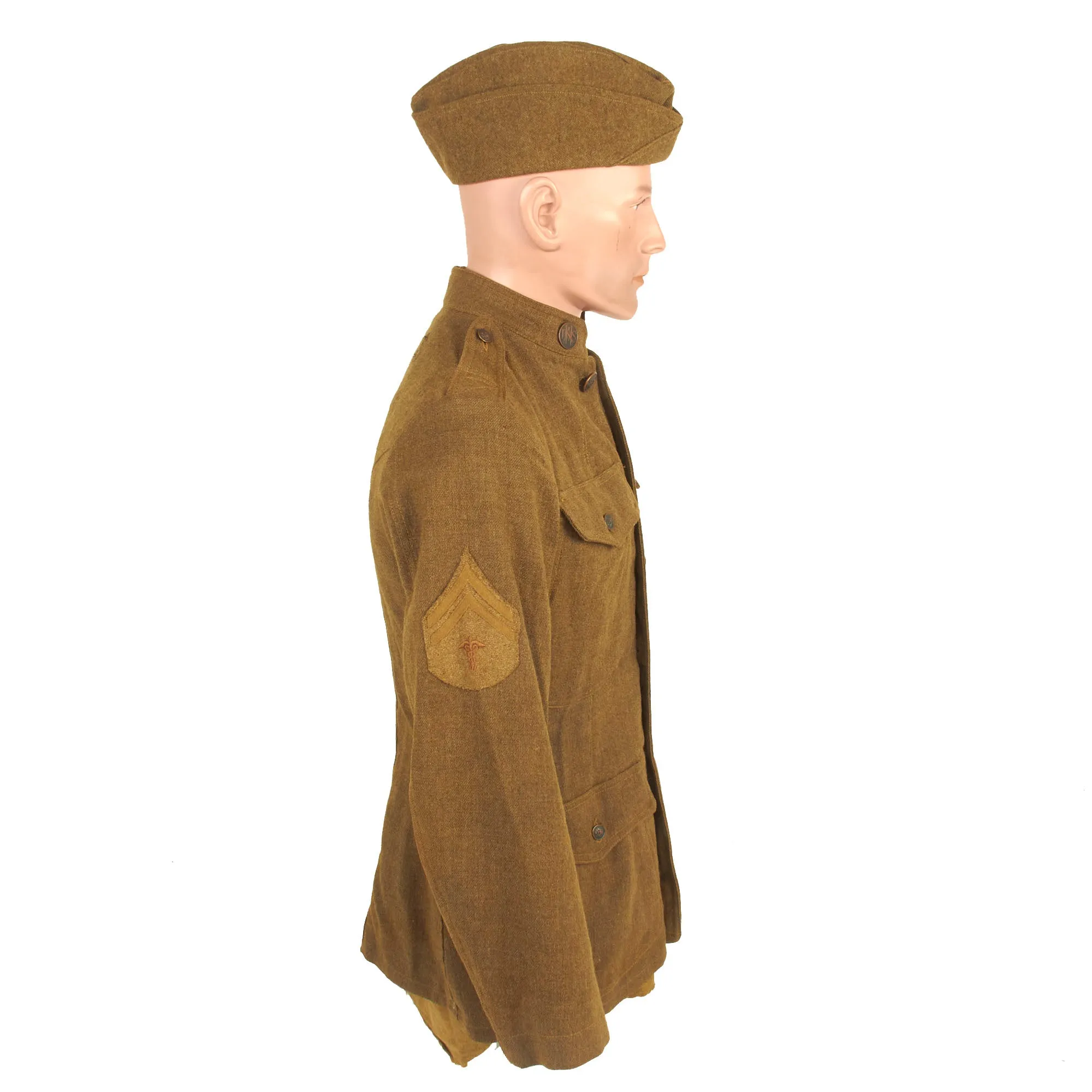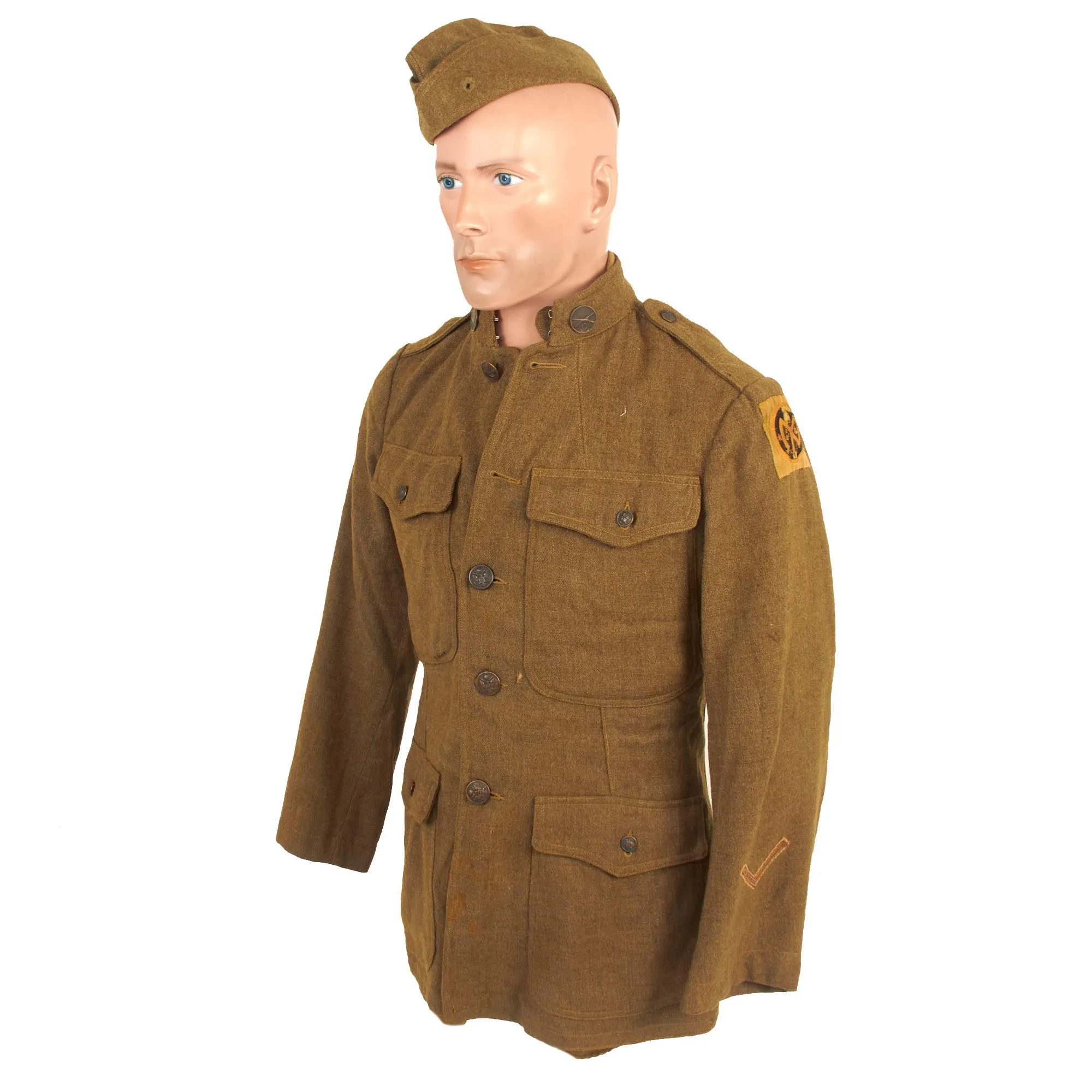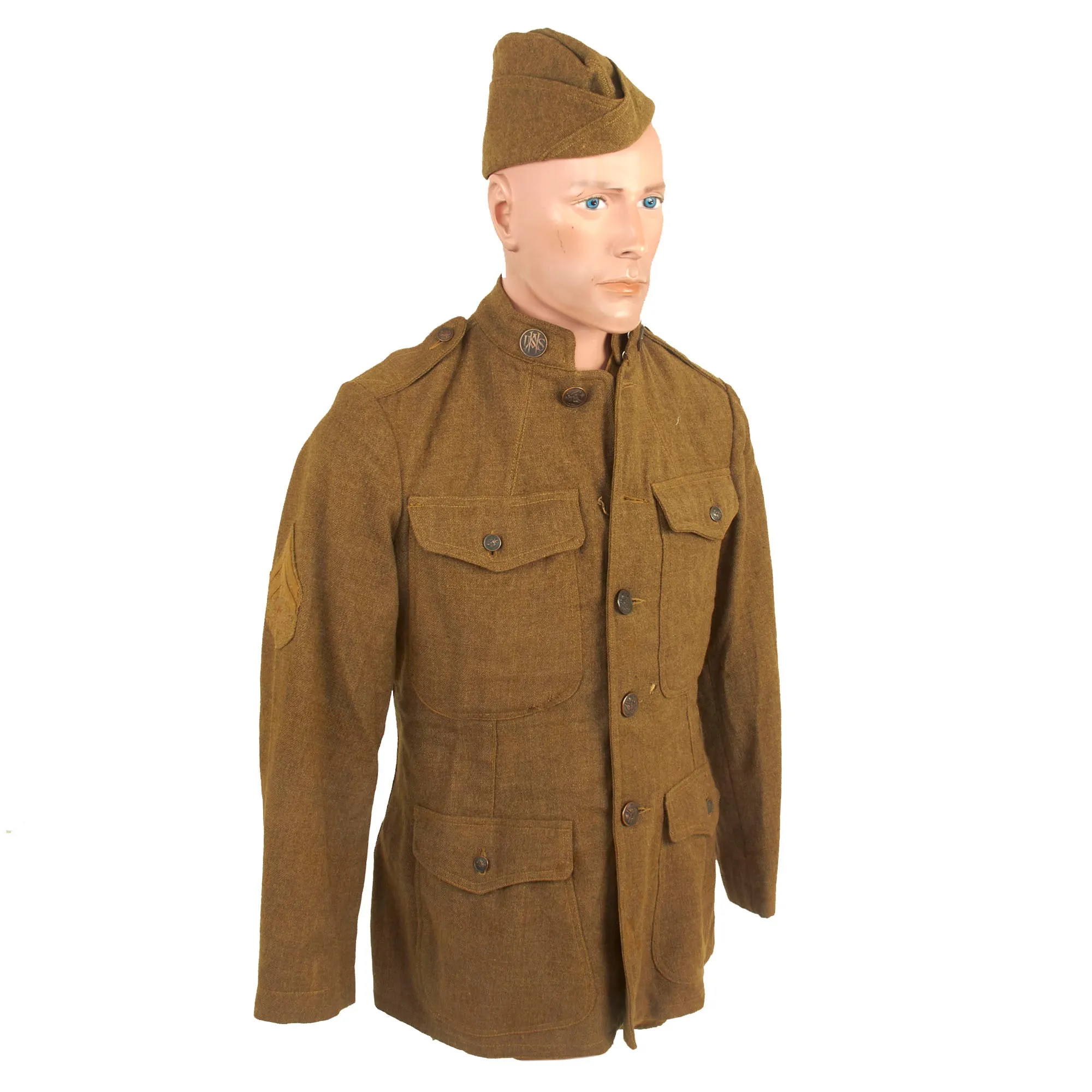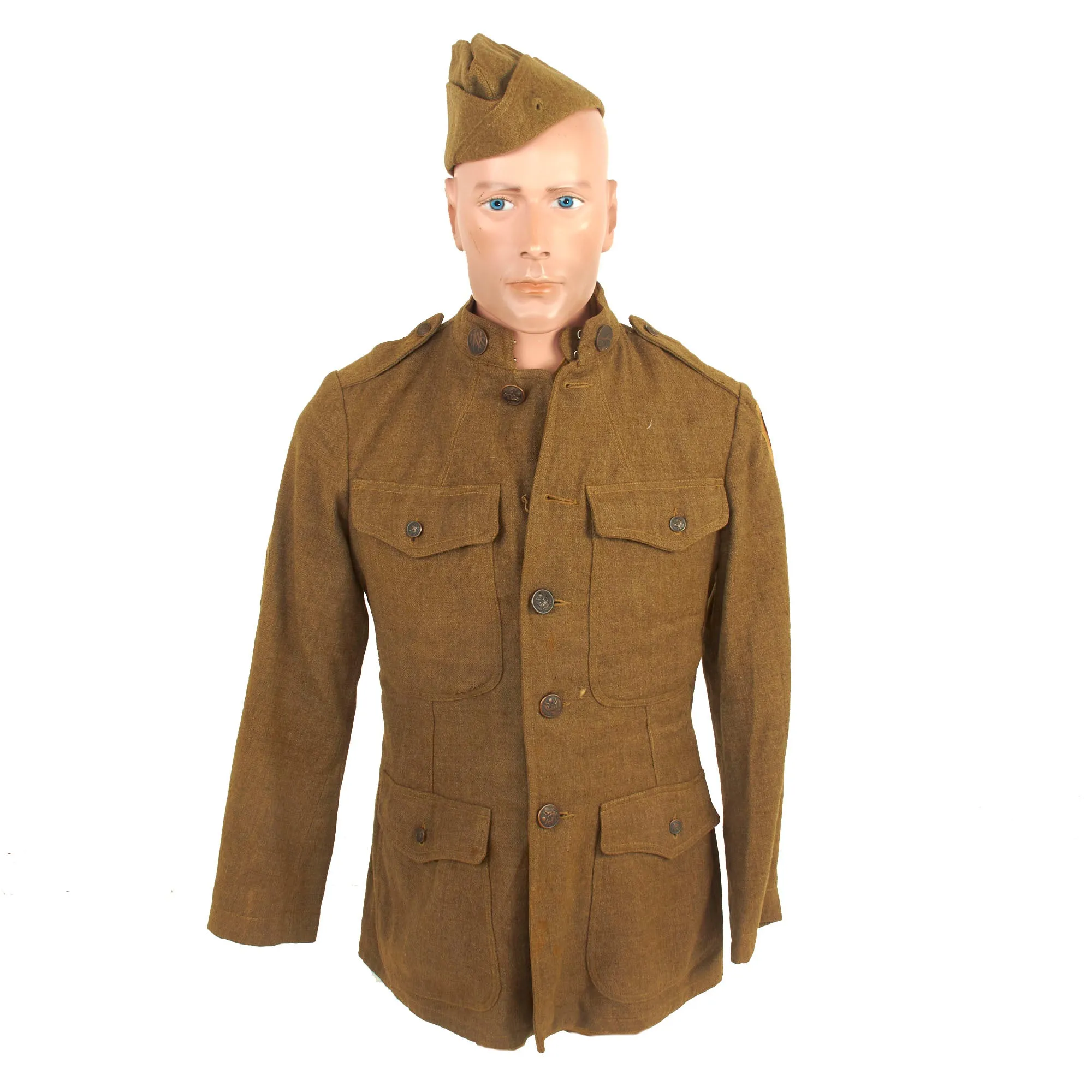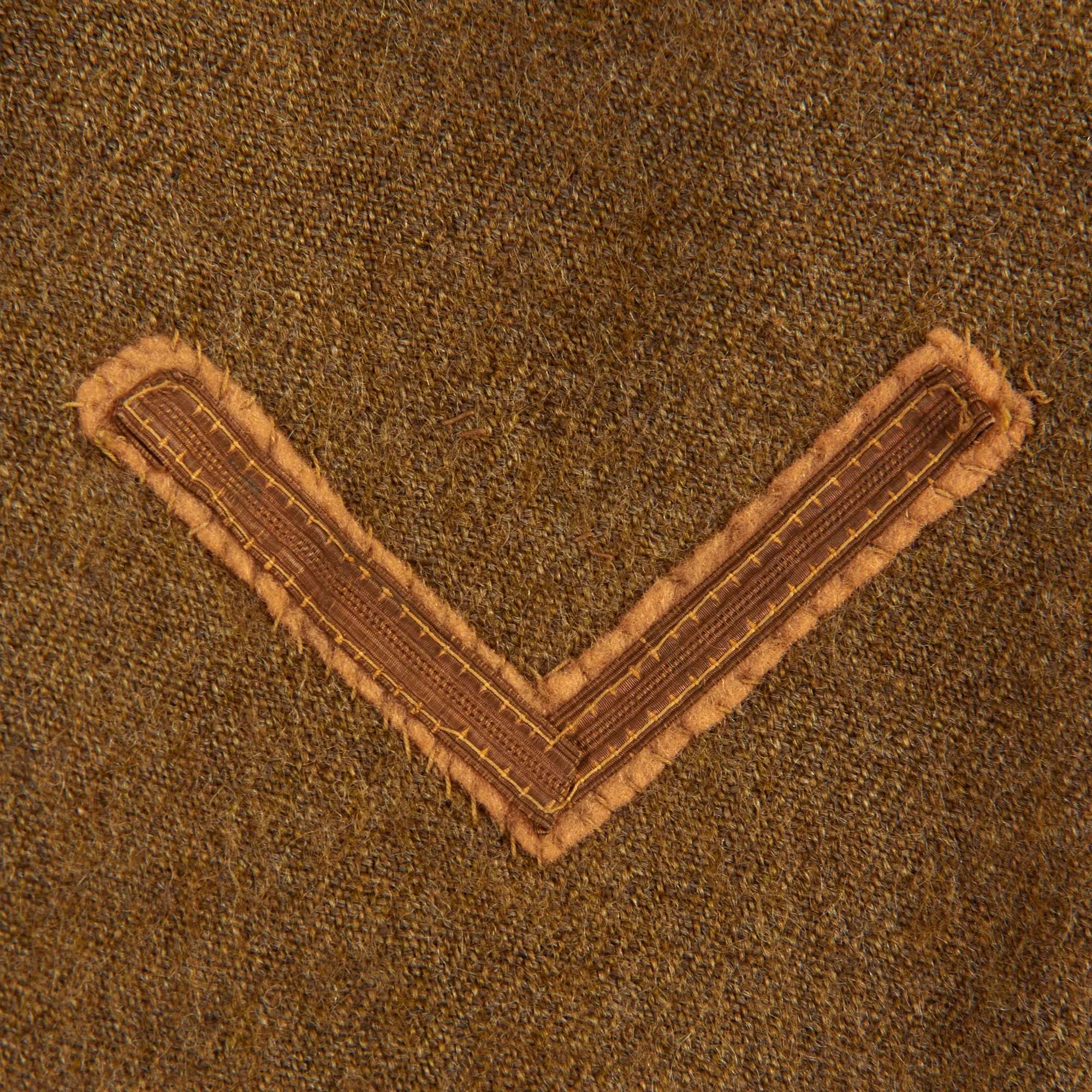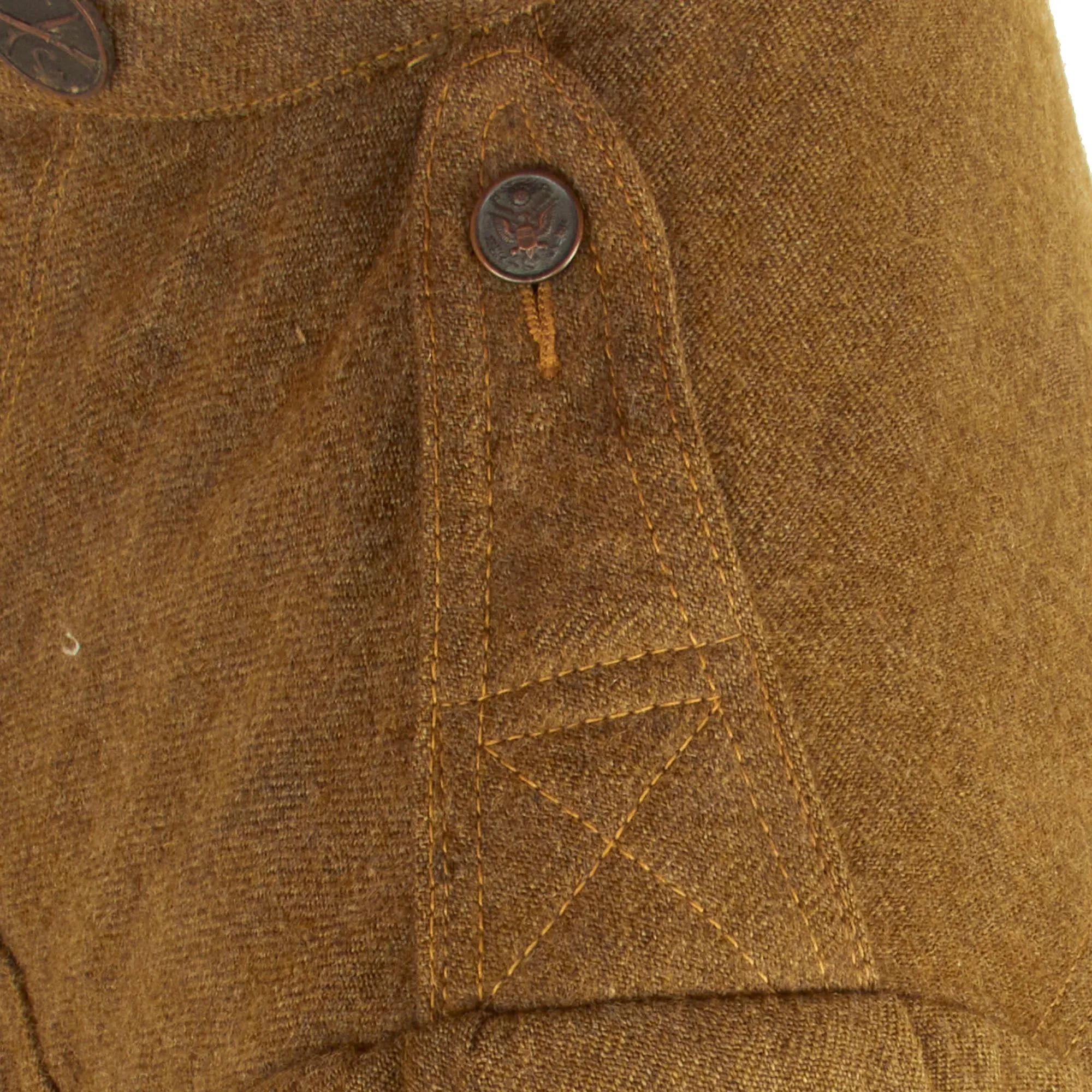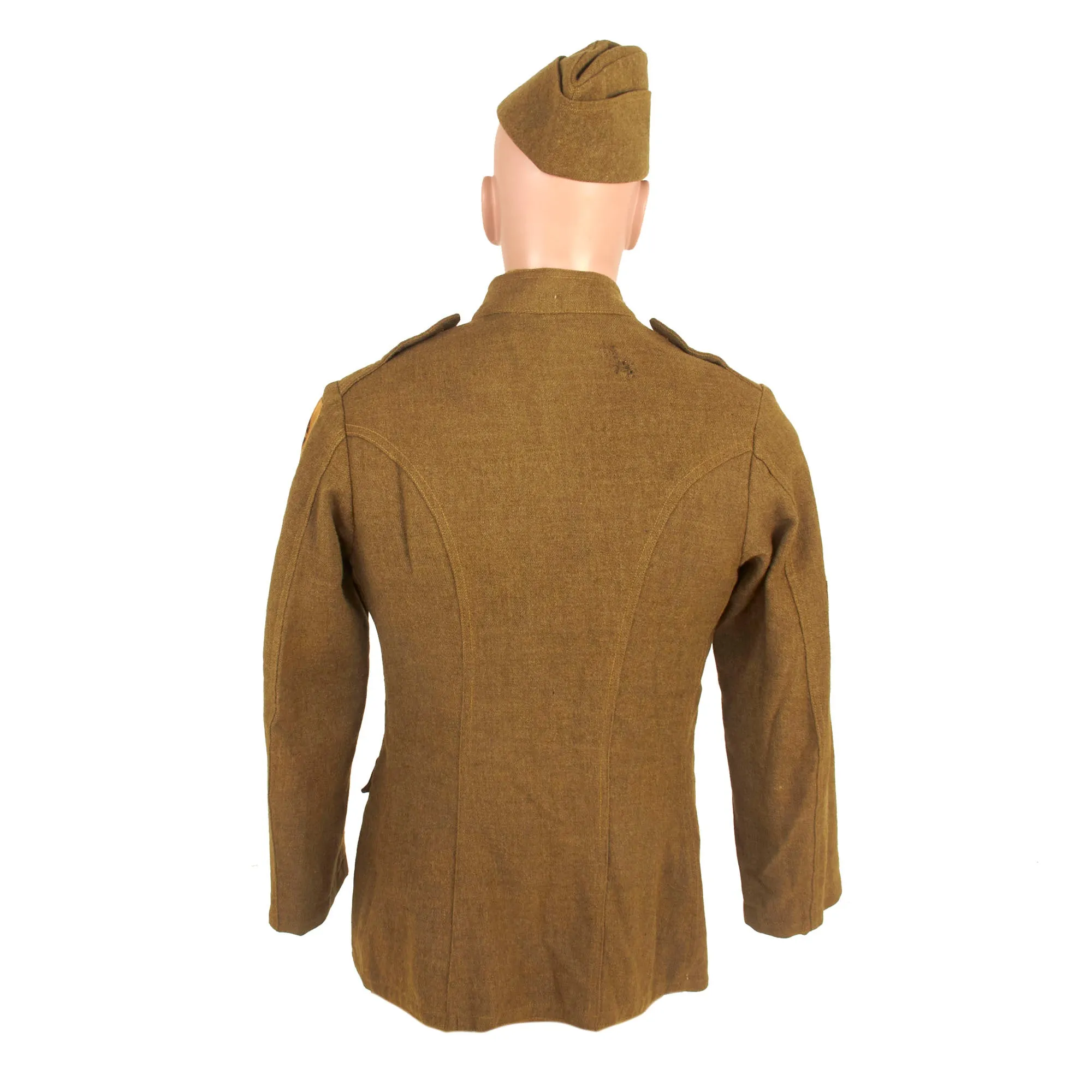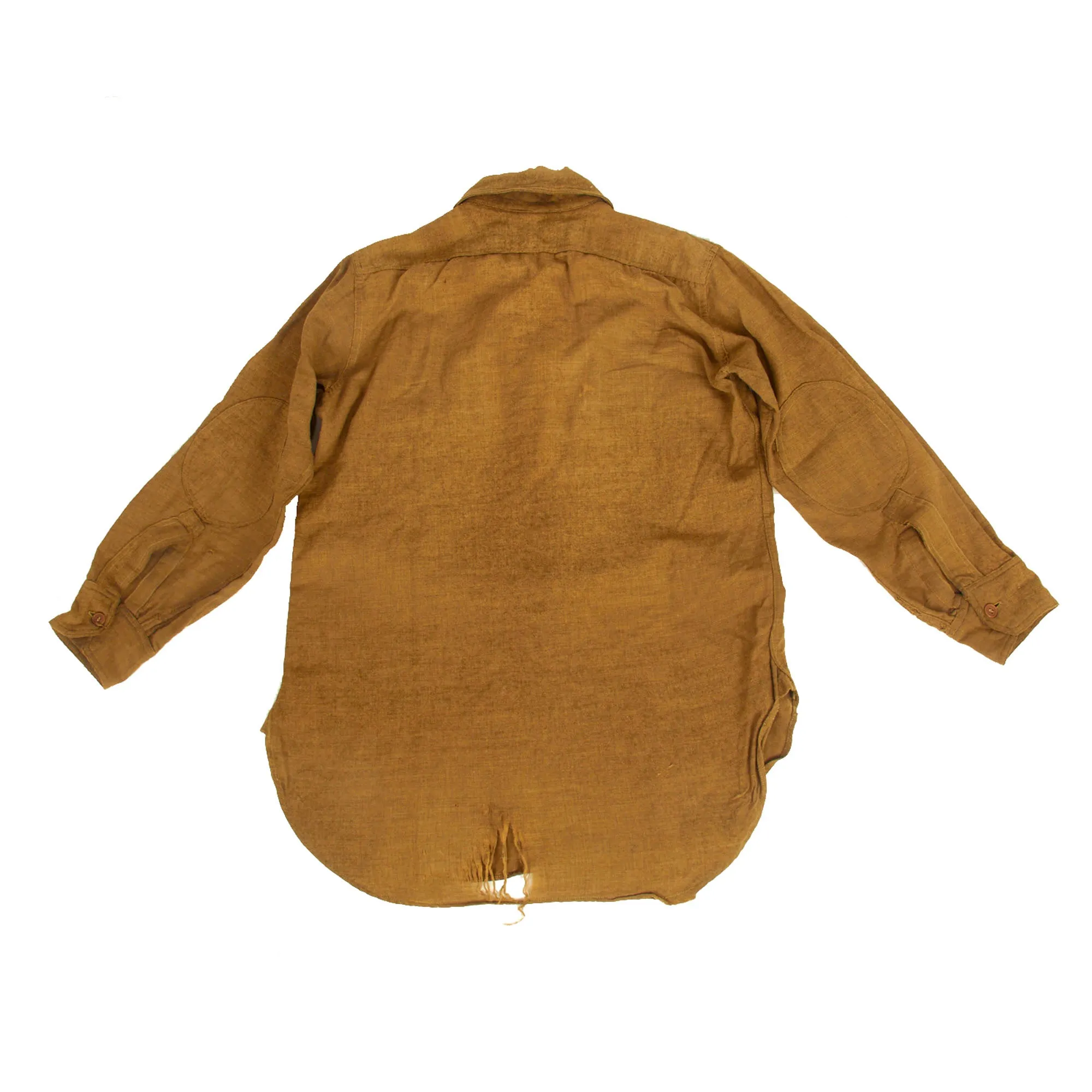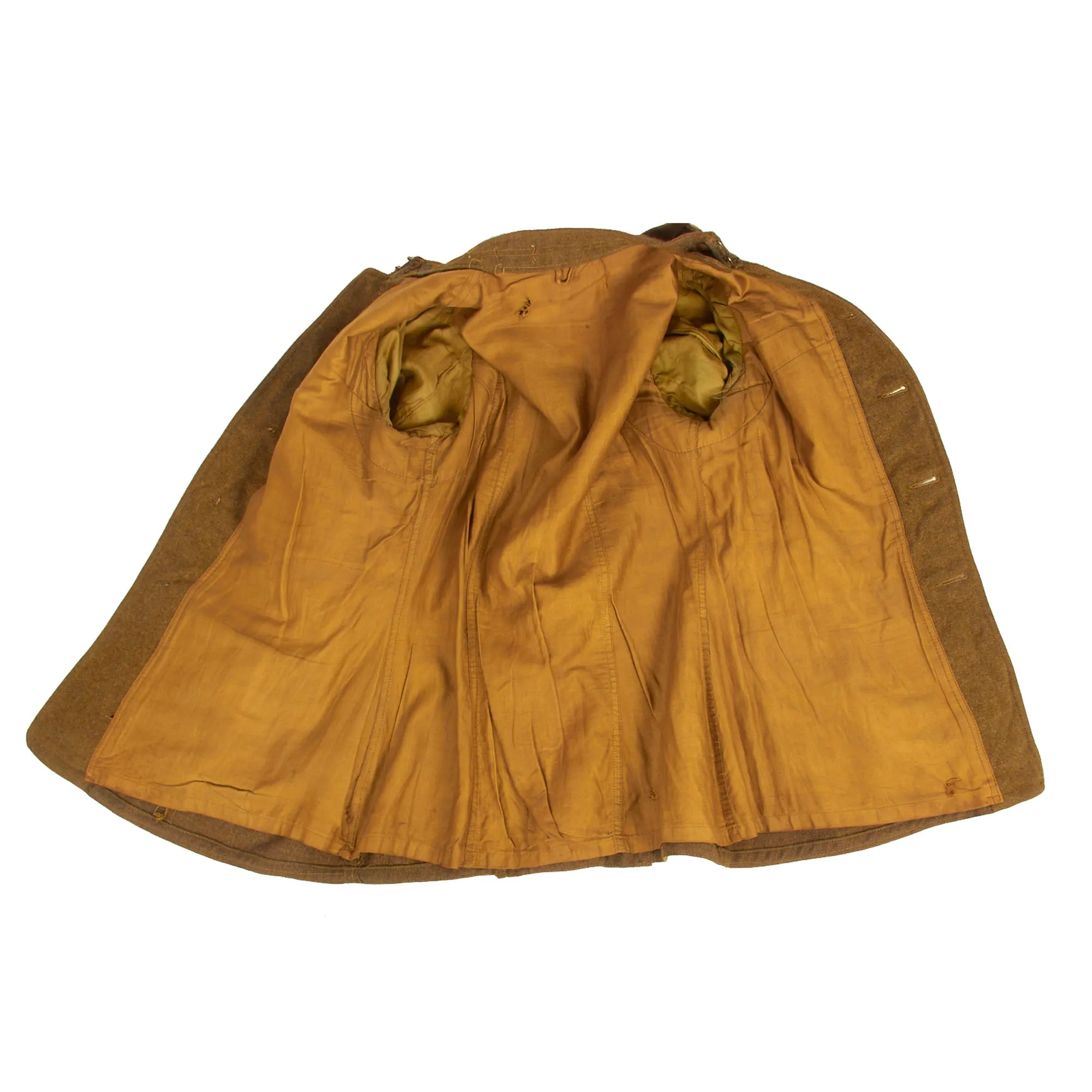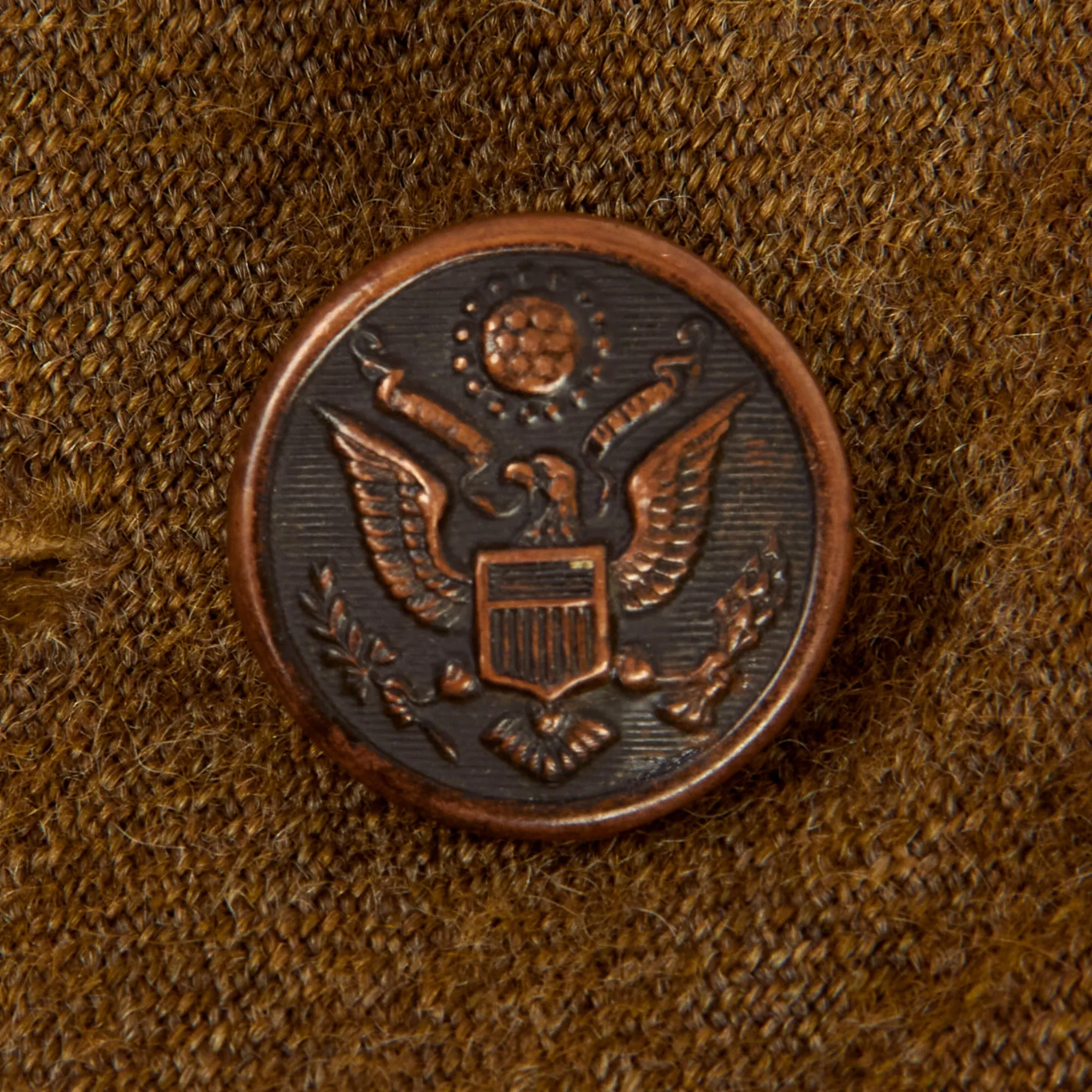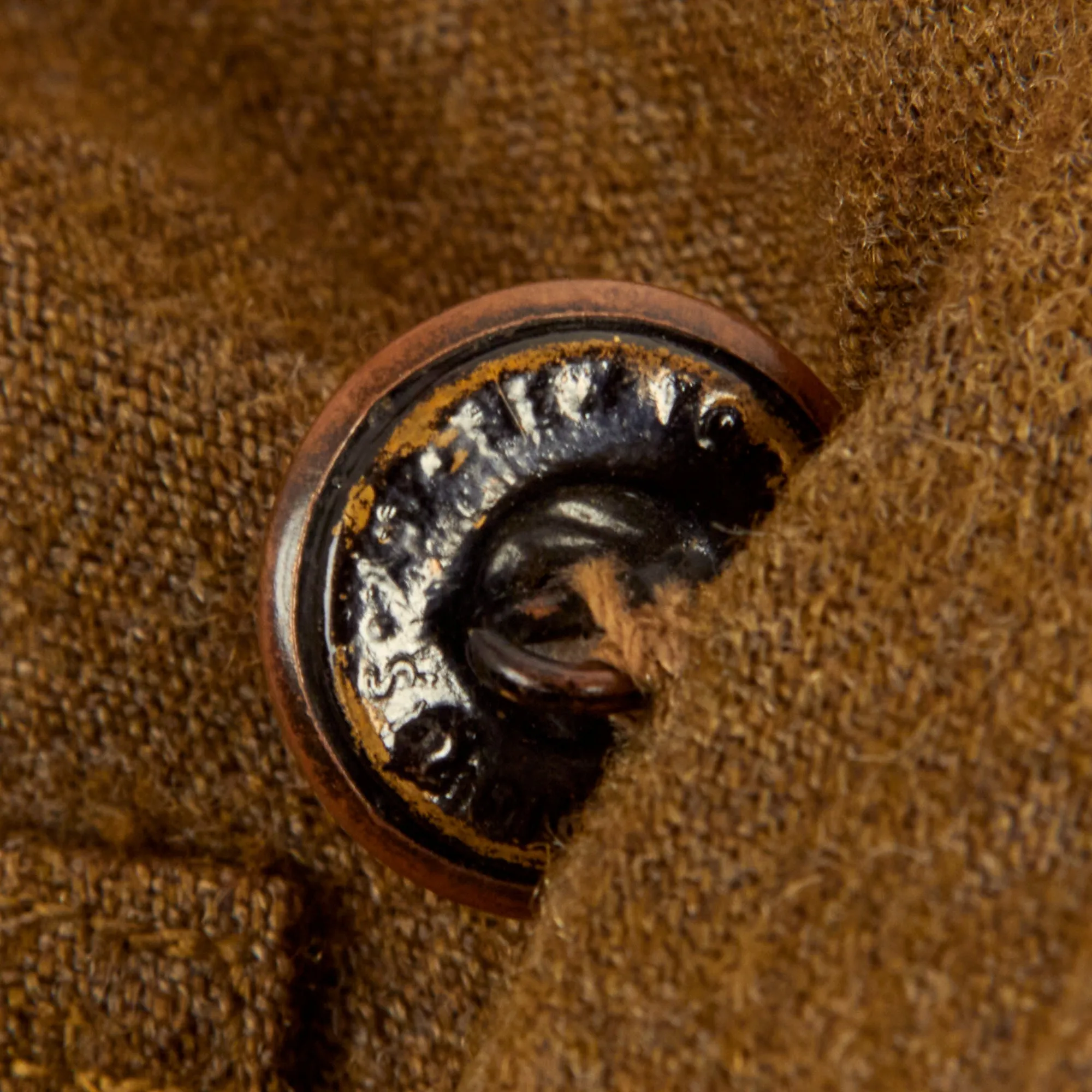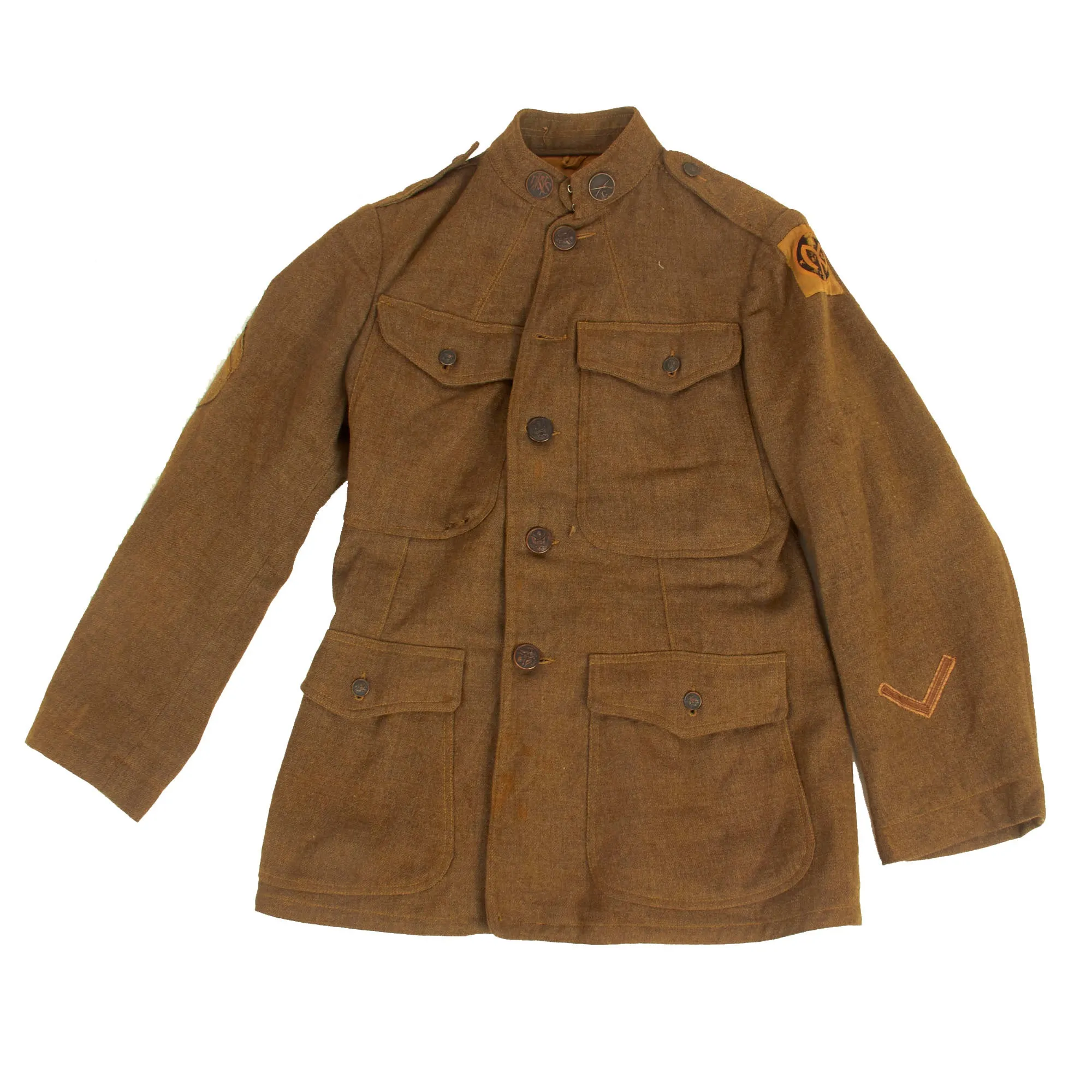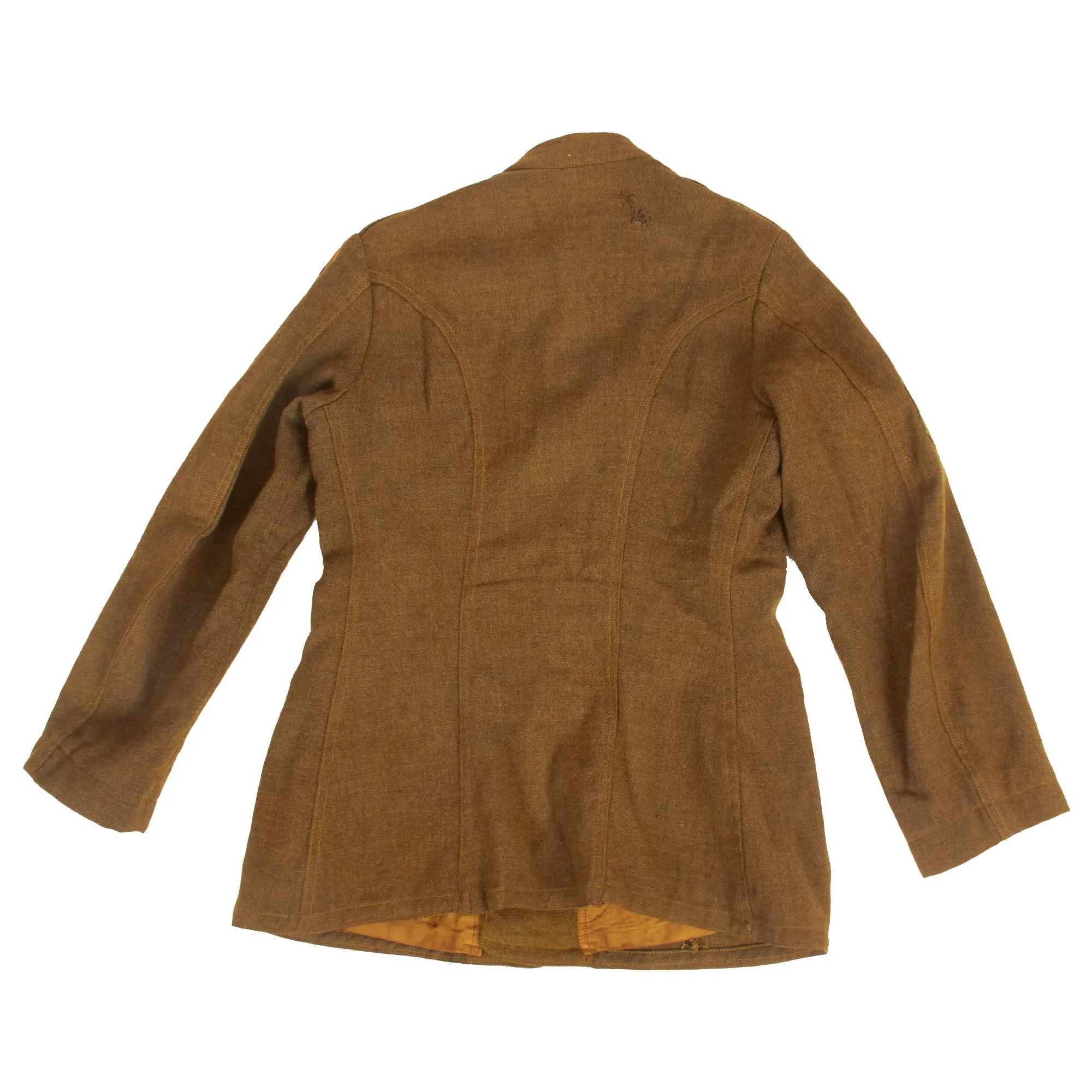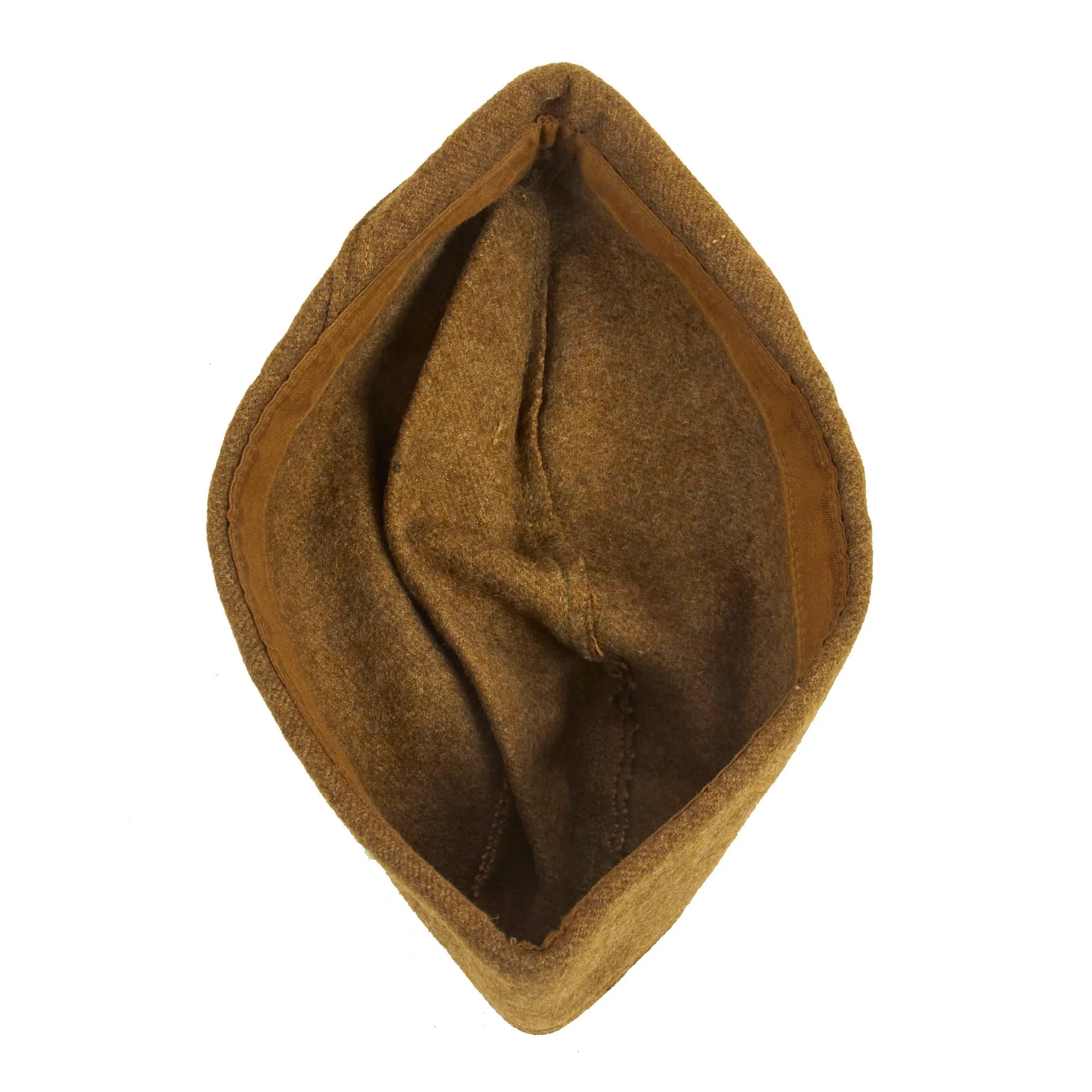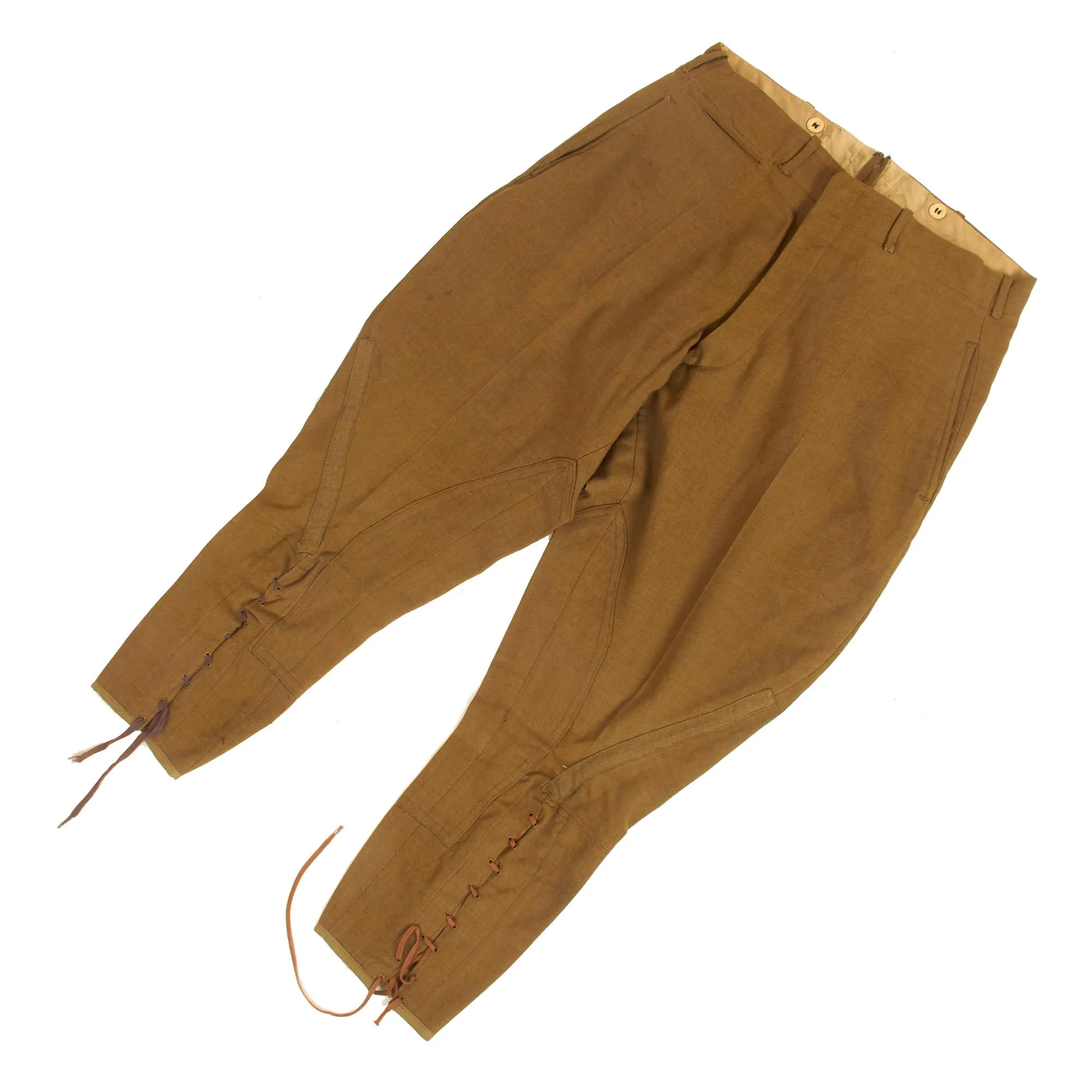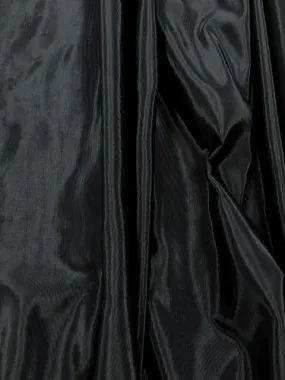Original Item: Only One Available. When the New York Division was organized in 1908, New York became the second state, after Pennsylvania, to structure its National Guard at such a high tactical level in peacetime. The New York Division was called to active duty during the Mexican border crisis of 1916. While on federal duty, it was redesignated as the 6th Division in June 1916. It was released from active duty in December 1916, only to be recalled for World War I service in July 1917. The 6th Division was reorganized and redesignated as the 27th Division on 1 October 1917.
This set includes a beautiful 27th Infantry Division patched tunic with 1917 National Guard collar discs featured on the cuff style collar. The tunic is completed with all buttons and snaps and is in great condition with very minor moth nips. The 27th division “NYD” shoulder patch was hand sewn onto the left shoulder and is in beautiful condition with most of the thread retained. The chevrons on the right sleeve is also retained very nicely and are for a Corporal with the Caduceus signifying medic. The lining of the jacket is without damage but it does show very minor staining.
The trousers are a beautiful pair in similar condition to the tunic. They are without damage and still retain the drawstring down on the calf location of the jodphurs. Also included in this set is a lovely wool button down shirt.
There are no markings that can be found on any item, but that doesn’t make this uniform any less attractive! A truly stunning set welcomed into any WW1 AEF displays!
Approx. Dimensions:
Jacket -
Collar to shoulder: 9.5"
Shoulder to sleeve: 23.5”
Shoulder to shoulder: 14.5”
Chest width: 19"
Waist width: 17"
Hip width: 22"
Front length: 31.5"
Shirts -
Collar to shoulder: 9.5"
Shoulder to sleeve: 22”
Shoulder to shoulder: 17.5”
Chest width: 22"
Waist width: 22"
Hip width: 15"
Front length: 33"
Pants:
Waist: 16.5"
Inseam: 23"
The 27th Infantry Division In World War I
Formation
Following the declaration of war on the Central Powers by the United States, the division was called into federal service on 15 July 1917, and hastily recruited New Yorkers to increase its numbers.
The division was one of only four divisions formed during the war from National Guard units entirely from a single state; the other divisions so formed were from Illinois (the 33rd Division), Ohio (the 37th Division), and Pennsylvania (the 28th Division). However, not all New Yorkers served in the 27th. Its initial strength was 991 officers and 27,114 enlisted men. The division's initial organization of three brigades with three infantry regiments each was carried over from the 6th Division
Prior to its departing to training, the division participated in a large send-off parade in New York City along 5th Avenue on 30 August 1917. The 7th Infantry Regiment was the first to leave for training on 11 September 1917, by train. The training was conducted at a purpose-built temporary facility at Camp Wadsworth, Spartanburg, South Carolina. Nearby hotels such as the Cleveland Hotel became centers for social life. The camp also housed seven YMCA Huts and a Knights of Columbus Hall. While the 27th had African-American service-men they were not permitted to enter the service organization clubs on base, which were segregated, until a black soldier's club was built in early 1918.
In the spring of 1918, the division began its movement toward embarkation camps, and shipped out on 20 April 1918. The division's advance detachment left Hoboken on 2 May and arrived at Brest, France, 10 May 1918. Late in June the last units of the 27th Division had arrived safely overseas.
Western Front
From the arrival of the first troops to the Western Front until 24 July, the division spent its time undertaking its final stages of training under British mentors in Picardy and Flanders. On 25 July, the 27th Division, excluding its artillery brigade and ammunition train, occupied the Dickebusch Lake and Scherpenberg sectors in Flanders.
In just over a month, this operation merged into the Ypres-Lys action, and then, from 19 August to 3 September, the 27th was on its own.
It was decided by Field marshal Douglas Haig that the Fourth Army's Australian Corps would lead the Battle of St. Quentin Canal . However, due to the Corps depleted nature, which was a result of fighting almost continuously, it would be reinforced by the 27th and 30th divisions, which resulted in II Corps being temporarily reassigned under Australian command. This great Somme "push", which lasted from 24 September to 1 October, saw the 27th engaged in severe fighting along the Saint Quentin Canal Tunnel—one of the out-lying strong points of the Hindenburg Line. At the conclusion of the first phase of the battle, and following heavy losses, the 27th was placed into reserve for rest and recuperation. Six days later, the division was sent back into the line, moving steadily toward Busigny whilst chasing the retreating Germans. These operations were supported by Australian Artillery until 9 October, when British artillery units began supporting the division's operations. As a result of these offensives by the Australian, British and US forces, the Hindenburg's Main Line was penetrated.
The 52d Field Artillery Brigade and the 102nd Ammunition Train of the New York Division had not gone with the rest of the Twenty-seventh Division to the British front in Flanders. They had moved up on 28 October, to support the Seventy-Ninth Division in the Argonne.
Meanwhile, the Twenty-Seventh Division units which had seen heavy action in Flanders, had moved back to an area near the French seaport of Brest.
Major Operations: Meuse-Argonne (only the artillery), Ypres-Lys, Somme Offensive.
Initially stationed in the East Poperinghe Line.
Battle of Dickebusche Lake, Summer 1918
Battle of Vierstraat Ridge, Summer 1918
Struggled to break the German defensive Hindenburg Line, September 1918.
Second battle of the Somme, 25 September 1918
Selle River, November 1918
The 27th did break the Hindenburg line during the Battle of the Somme and forced a German retreat from their defensive line and forced the Germans to a final confrontation. After a final confrontation with the retreating Germans at the Selle River the Armistice ended the fighting and the division was sent home in February 1919, to be mustered out several months later. The division had sustained a total of 8,334 (KIA: 1,442; WIA: 6,892) casualties when it was inactivated in April 1919.





